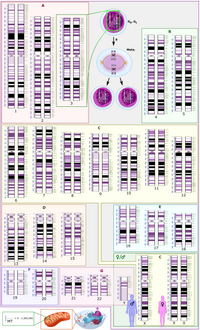
Photo from wikipedia
Lung cancer is primarily responsive for cancer death, and its progression is aggressively affected by copy number variation (CNV). Through bioinformatics approach, a ceRNA network of CNV‐driven lncRNAs in lung… Click to show full abstract
Lung cancer is primarily responsive for cancer death, and its progression is aggressively affected by copy number variation (CNV). Through bioinformatics approach, a ceRNA network of CNV‐driven lncRNAs in lung squamous cell carcinoma (LUSC) patients was constructed. Data on normal and LUSC tumor tissue from The Cancer Genome Atlas (TCGA)‐LUSC dataset were subjected to differential analysis, and differentially expressed lncRNAs (DElncRNAs), DEmiRNAs, and DEmRNAs were obtained. Based on TCGA‐LUSC, CNVs of normal and tumor tissue samples were then compared using a Chi‐square test, and lncRNAs were intersected based on their CNVs and expression alternation. In combination with the Kruskal‐Wallis test, CNV‐driven lncRNAs were acquired. Afterwards, miRNAs and mRNAs that interacted with CNV‐driven lncRNAs were obtained based on databases (LncBase, starBase, miRDB, mirDIP and TargetScan), DElncRNAs, DEmiRNAs and DEmRNAs, and correlation analysis. The acquired lncRNAs, miRNAs and mRNAs were subjected to Cytoscape software to construct a CNV‐driven ceRNA network, which involved 5 lncRNAs (MIR143HG, LINC00702, MIR22HG, RP11‐180 N14.1, RP11‐473 M20.9), 6 miRNAs (miR‐3200‐3p, miR‐1301‐3p, miR‐93‐3p, miR‐96‐5p, miR‐96‐5p, miR‐130b‐5p, miR‐205‐5p) and 80 mRNAs. Kyoto Encyclopedia of Genes and Genomes and Gene Ontology enrichment analyses indicated that downstream mRNAs were mainly correlated with blood vessel development and T cell‐mediated immunity. In summary, we devoted to analyzing CNV‐related lncRNAs, mRNAs, and miRNAs in LUSC, thus clarifying 5 lncRNAs that may influence the malignant progression of LUSC. The ceRNA network regulated by these lncRNAs may be the novel pathogenesis of LUSC.
Journal Title: Environmental and Molecular Mutagenesis
Year Published: 2022
Link to full text (if available)
Share on Social Media: Sign Up to like & get
recommendations!